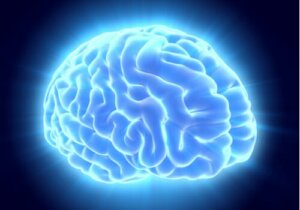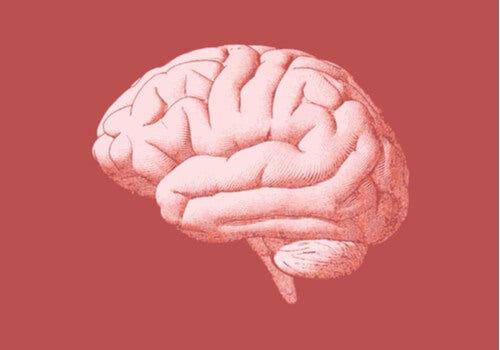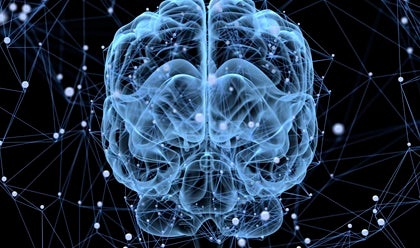Your Brain Deceives You: Persinger's Experiment

Persinger’s experiment shows that your brain can deceive you. On more than one occasion, you probably trusted your senses and they ended up fooling you. It’s precisely due to the trust you have in your perception and the complexity of your environment that reality often plays tricks on you.
You can get confused about people, see things that aren’t really there, and think there’s someone with you when there isn’t anyone. Biologically, hallucinations are an alteration of perception. This alteration has a strong cerebral basis, since the areas of maximum sensory processing are found there.
Persinger and the sensation of presence
Dr. Persinger’s studies focus on demonstrating that many phenomena interpreted as spiritual are actually cerebral. The sensation of presence is the phenomenon of feeling or perceiving another person or entity when there’s nothing there.

A phenomenon linked to different illnesses or conditions
These experiences can be linked to different illnesses or conditions. The main one is sleep paralysis, where the person feels stalked by something. You can also find it in epilepsy and neurodegenerative diseases. In the latter, scientists explain it as the alteration of brain structures linked to perception.
The theory of vector hemisphericity
This theory is based on the fact that the construction of the human “self” is a process that both cerebral hemispheres participate in, in a distinct, joint, and non-conscious way.
First of all, the left hemisphere provides the linguistic and symbolic sense of self (internal dialogue). According to Persinger, during processes that alter interhemispheric connectivity, there’s an intrusion of the right hemisphere’s perceptive of self into the left.
This intrusion would cause your left hemisphere to interpret the perception of the right hemisphere’s “self” as the presence of another person, when in fact it’s simply you. Persinger set out to prove his theory by means of several experiments.
The brain areas implicated in the phenomenon
- Parietal lobe. Or, more precisely, the area of motor and perceptual association. This is the so-called Penfield homunculus, where each organ and part of the body has its own area assigned to it in the cerebral cortex.
- Temporal lobe. This is the lobe that integrates stimuli from hearing and processes language. The junction between the parietal and temporal lobe is often the cause of perceptual errors.
- Occipital lobe. This is the lobe in charge of vision. Disturbances in the other two lobes can lead to visual errors.
Persinger’s experiment
Dr. Michael Persinger knew how difficult it was to prove his theory, but scientific progress was on his side. He thought that he could provoke an alteration in brain connectivity, a process that would cause the intrusion of one hemisphere into another. The instrument selected for the experiments was transcranial magnetic stimulation.
The God Helmet
Based on previous research, Persinger designed a helmet with four pairs of selenoids that magnetically stimulated the temporal lobe. He called this helmet “the God Helmet“.
He conducted the experiment in a dark room and blindfolded the volunteers. At the end of the experiment, he asked the volunteers if they had felt a strange presence, sound, or smell. Many of them claimed to have felt something, when, in fact, there was nothing.
Elements of the experiment
- Sensory deprivation. Science has shown that the inability to see increases long-wave brain activity. Such activity is very present in sensory failures.
- Magnetic stimulation. With a small excitation of neurons in the cerebral cortex, the overall connectivity of the brain can be altered. In addition, the experiment performed the stimulation at the junction of the temporal and parietal lobe, an area involved in these processes.
- Relaxed environment. An area free of distractions causes relaxation. In conjunction with sensory deprivation, this triggers the patient’s imagination and causes uncertainty, causing false sensations.
The results of the experiment
Persinger performed this experiment repeatedly and, in the vast majority of cases, the subjects had very strange sensations. Some reported the sensation that another person was there, whereas others felt strange smells or heard voices. It’s important to emphasize that the person was completely alone in the room.
To keep in mind
Here are some aspects to consider regarding Persinger’s experiments:
- The influence of fantasy. People who are generally open to mystical experiences have high expectations. Therefore, they may be predisposed to having something happen that they end up provoking it.
- Meditation. In another experiment by Persinger, people who often meditated reached the state of relaxation more easily and were more open to perceptual alterations.
- Beliefs. Persinger’s experiment also showed that religious people were more likely to interpret the phenomenon as a mystical apparition. In doing so, they were able to be more precise about what they felt they perceived.
- Culture. The mental ideas attributed to the perceptual alterations are closely linked to the person’s culture. People from cultures with a greater interest and history regarding the subject will be more likely to experience the phenomenon.

Conclusions of the experiments
Persinger showed that stimulation in a particular area of the brain caused perceptual failures. This points to the fact that we can explain phenomena that some people consider to be mystical by events that occur in the brain. He also demonstrated that the alteration of the brain areas associated with perception has a great incidence in hallucinations.
Pathological cases
Dr. Persinger’s conclusions explain why people with brain lesions, epilepsy, or dementia have a high rate of these phenomena. The structural alteration of the brain causes the desynchronization between both hemispheres and, as a consequence, perceptual errors occur.
A critical view
Through his experiments, Persinger has enabled a critical look at hallucinations that are often tinged with personal beliefs. The brain contains a map of our body, and if something goes wrong, it can misinterpret what it perceives. Persinger’s experiment has helped us to study less frequent hallucinatory phenomena from another perspective.
Persinger’s experiment shows that your brain can deceive you. On more than one occasion, you probably trusted your senses and they ended up fooling you. It’s precisely due to the trust you have in your perception and the complexity of your environment that reality often plays tricks on you.
You can get confused about people, see things that aren’t really there, and think there’s someone with you when there isn’t anyone. Biologically, hallucinations are an alteration of perception. This alteration has a strong cerebral basis, since the areas of maximum sensory processing are found there.
Persinger and the sensation of presence
Dr. Persinger’s studies focus on demonstrating that many phenomena interpreted as spiritual are actually cerebral. The sensation of presence is the phenomenon of feeling or perceiving another person or entity when there’s nothing there.

A phenomenon linked to different illnesses or conditions
These experiences can be linked to different illnesses or conditions. The main one is sleep paralysis, where the person feels stalked by something. You can also find it in epilepsy and neurodegenerative diseases. In the latter, scientists explain it as the alteration of brain structures linked to perception.
The theory of vector hemisphericity
This theory is based on the fact that the construction of the human “self” is a process that both cerebral hemispheres participate in, in a distinct, joint, and non-conscious way.
First of all, the left hemisphere provides the linguistic and symbolic sense of self (internal dialogue). According to Persinger, during processes that alter interhemispheric connectivity, there’s an intrusion of the right hemisphere’s perceptive of self into the left.
This intrusion would cause your left hemisphere to interpret the perception of the right hemisphere’s “self” as the presence of another person, when in fact it’s simply you. Persinger set out to prove his theory by means of several experiments.
The brain areas implicated in the phenomenon
- Parietal lobe. Or, more precisely, the area of motor and perceptual association. This is the so-called Penfield homunculus, where each organ and part of the body has its own area assigned to it in the cerebral cortex.
- Temporal lobe. This is the lobe that integrates stimuli from hearing and processes language. The junction between the parietal and temporal lobe is often the cause of perceptual errors.
- Occipital lobe. This is the lobe in charge of vision. Disturbances in the other two lobes can lead to visual errors.
Persinger’s experiment
Dr. Michael Persinger knew how difficult it was to prove his theory, but scientific progress was on his side. He thought that he could provoke an alteration in brain connectivity, a process that would cause the intrusion of one hemisphere into another. The instrument selected for the experiments was transcranial magnetic stimulation.
The God Helmet
Based on previous research, Persinger designed a helmet with four pairs of selenoids that magnetically stimulated the temporal lobe. He called this helmet “the God Helmet“.
He conducted the experiment in a dark room and blindfolded the volunteers. At the end of the experiment, he asked the volunteers if they had felt a strange presence, sound, or smell. Many of them claimed to have felt something, when, in fact, there was nothing.
Elements of the experiment
- Sensory deprivation. Science has shown that the inability to see increases long-wave brain activity. Such activity is very present in sensory failures.
- Magnetic stimulation. With a small excitation of neurons in the cerebral cortex, the overall connectivity of the brain can be altered. In addition, the experiment performed the stimulation at the junction of the temporal and parietal lobe, an area involved in these processes.
- Relaxed environment. An area free of distractions causes relaxation. In conjunction with sensory deprivation, this triggers the patient’s imagination and causes uncertainty, causing false sensations.
The results of the experiment
Persinger performed this experiment repeatedly and, in the vast majority of cases, the subjects had very strange sensations. Some reported the sensation that another person was there, whereas others felt strange smells or heard voices. It’s important to emphasize that the person was completely alone in the room.
To keep in mind
Here are some aspects to consider regarding Persinger’s experiments:
- The influence of fantasy. People who are generally open to mystical experiences have high expectations. Therefore, they may be predisposed to having something happen that they end up provoking it.
- Meditation. In another experiment by Persinger, people who often meditated reached the state of relaxation more easily and were more open to perceptual alterations.
- Beliefs. Persinger’s experiment also showed that religious people were more likely to interpret the phenomenon as a mystical apparition. In doing so, they were able to be more precise about what they felt they perceived.
- Culture. The mental ideas attributed to the perceptual alterations are closely linked to the person’s culture. People from cultures with a greater interest and history regarding the subject will be more likely to experience the phenomenon.

Conclusions of the experiments
Persinger showed that stimulation in a particular area of the brain caused perceptual failures. This points to the fact that we can explain phenomena that some people consider to be mystical by events that occur in the brain. He also demonstrated that the alteration of the brain areas associated with perception has a great incidence in hallucinations.
Pathological cases
Dr. Persinger’s conclusions explain why people with brain lesions, epilepsy, or dementia have a high rate of these phenomena. The structural alteration of the brain causes the desynchronization between both hemispheres and, as a consequence, perceptual errors occur.
A critical view
Through his experiments, Persinger has enabled a critical look at hallucinations that are often tinged with personal beliefs. The brain contains a map of our body, and if something goes wrong, it can misinterpret what it perceives. Persinger’s experiment has helped us to study less frequent hallucinatory phenomena from another perspective.
This text is provided for informational purposes only and does not replace consultation with a professional. If in doubt, consult your specialist.







